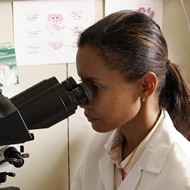
Environmental Factor, November 2008, National Institute of Environmental Health Sciences
Distinguished Lecture on Biology of DNA
By Robin Arnette
November 2008
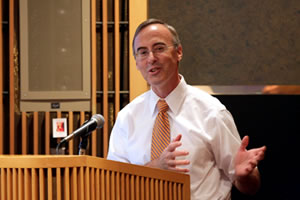
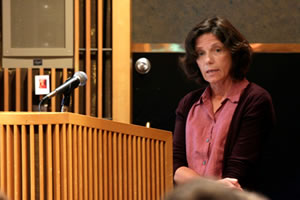
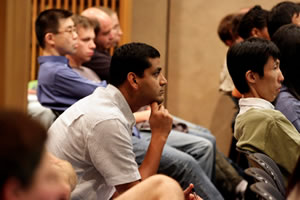
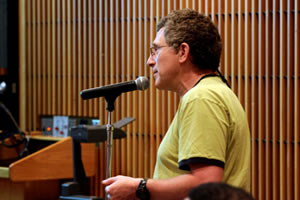
Many scientists have uncovered the mechanisms involved in DNA replication, repair and recombination. One of those researchers, Tom Ellenberger, D.V.M., Ph.D., visited NIEHS recently and gave a seminar that focused on his contribution to this body of knowledge. The presentation, titled "Structural Biology of DNA End Joining," took place at Rodbell Auditorium on October 14. Kasia Bebenek, Ph.D., a staff scientist in the Laboratory of Molecular Genetics, hosted the talk.
Ellenberger (http://www.biochem.wustl.edu/faculty/tome.html)![]() is a Wittcoff Professor and head of the Department of Biochemistry and Molecular Biophysics at Washington University School of Medicine in St. Louis. His work provides a foundation for understanding how mutations affecting the proteins that are involved in these processes cause chromosomal instability and disease.
is a Wittcoff Professor and head of the Department of Biochemistry and Molecular Biophysics at Washington University School of Medicine in St. Louis. His work provides a foundation for understanding how mutations affecting the proteins that are involved in these processes cause chromosomal instability and disease.
Ellenberger is particularly interested in why mammalian cells have three different families of DNA ligases — enzymes that join two DNA molecules together in an energy-dependent process — and what contributes to the biological specificities of those enzymes. Before Ellenberger delved into his research, he gave a brief overview of ligases and why they were important.
He said that most DNA damage is repaired by cutting out the damaged segment of DNA — whether it was a single nucleotide in the case of base excision repair (BER) or a stretch of nucleotides surrounding the damaged region in the case of nucleotide excision repair (NER). During the repair process, polymerase fills in the gap and. once the damaged segment is removed, the ligase completes the ligation reaction. "Since ligases are central in all manner of DNA repair activities, they are crucial to the maintenance and stable transmission of genetic information from generation to generation," he explained.
According to Ellenberger, there are three families of mammalian ligases.
- Ligase I has the most abundant activity in replicating cells and was involved in the repair of Okazaki fragments, short pieces of lagging strand DNA, that were generated during replication.
- Ligase IV, involved in a double-strand break repair pathway known as non-homologous end joining (NHEJ), has the ability to "paste" together two ends of broken DNA. It also plays a role in the immune system.
- Ligase III is a repair enzyme with some overlap activity with the other two mammalian ligases.
"Ligases I and III are essential as they are required for mammalian development and the long-term viability of cells," Ellenberger said. "One reason why ligase III may be so important is it is the only identified ligase in mammalian mitochondria."
Ellenberger predicted that ligase I and ligase III were structurally similar, except for a unique zinc finger ligase III that had been previously described as a "DNA nick sensor." Biochemical and x-ray crystallographic studies of ligase III demonstrated that the enzyme had two separate DNA binding domains and was highly efficient at ligating together two DNAs, consistent with genetic studies showing that ligase III was involved in an alternative pathway of DNA double strand break repair.
By constructing a structural database of DNA ligases bound to their substrates and crystal data from ligase III, Ellenberger’s group inferred the types of motions that occurred in ligase III during the various steps of the ligation reaction. Ligase III had two separate nick-binding moieties, one at the amino-terminus and the other at the carboxyl-terminus. These two sites acted in sequence to repair the DNA. He said, "This turned into the jack-knife model, which says it’s a series of flexible hinges that open and close in different ways during the course of recognizing the nick and catalyzing DNA end joining."
"Working with the Media......" - previous story ![]()
![]() next story - "GEMS Meeting Highlights......"
next story - "GEMS Meeting Highlights......"
November 2008 Cover Page
